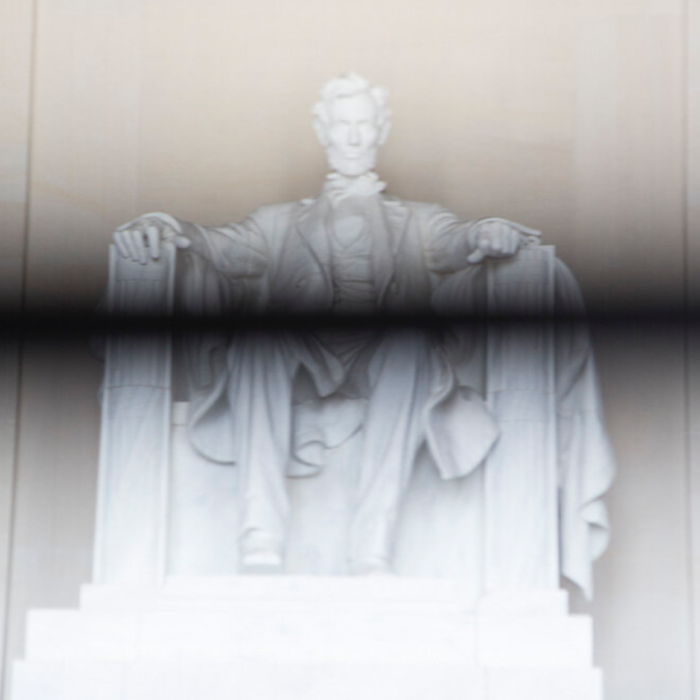Book Excerpt‘America’ (n): A Creation Myth

Nona Faustine, Land of Freedoms Heaven (detail), 2019
Prior to that, American Indians in the United States were considered “legal wards of the nation: living within and under U.S. control but lacking representation and full rights as individuals.” 1 Four years before Warhol’s birth, Warhol’s immigrant parents had more claim to America than the original stewards of the land. An Indigenous framework for the conceptualization of “America” and “Americanity” is necessary because whereas for Warhol America represented opportunity, for American Indians America was the entity that denied Indigenous peoples full personhood and rights to their ancestral lands, languages, and traditions.
United States citizenship for American Indians came less than one hundred years ago, and that citizenship remains abstract because their new legal status was not accompanied by an apology, a plan for reconciliation, or the redistribution of land. If it was, the America that Warhol wrote about, to, and from would not exist.
To approach a nuanced understanding of the mechanics of America as a creation myth, it is useful to visit one of Warhol’s most identifiable art pieces. Campbell’s Soup Cans (1962) stages thirty-two canvases, each depicting the packaging of a different variety of Campbell’s soup. Warhol’s method of appropriating and restaging the soup cans, naming the restaging as art, and thus changing the way the art world saw the cans is representative of how ideas, concepts, and values come to life in the United States.
The concept of America is continually restaged and re-presented to the public. We see this at the level of the law: Who is allowed to vote? Who is not? Which communities are the targets of voter suppression? Who is allowed to become a naturalized US citizen? And how long does the naturalization process take on the basis of gender, race, ethnicity, class status, and country of origin? What types of bodies are granted screen time on American television? All of these questions consider the persistent inconsistencies of America, and that’s one of the reasons why Warhol rejected the notion that there can ever be one “real America.” 2 For Warhol, there were many Americas within America, and according to him, each one is “moody.” 3 From an Indigenous perspective, however, there is only one America: the nation-state that has not made living as an Indigenous and, by extension, a targeted and minoritized subject easy. In Create Dangerously: The Immigrant Artist at Work (2011), the Haitian writer Edwidge Danticat notes that cultural production starts with a story, the “creation myth” that the artist is haunted by but also obsessed with. For Warhol, that creation myth was America. For many, America is still the haunting and the obsession of the everyday: The crisis of missing and murdered indigenous women and girls has American conquest and cultural hegemony as its backdrop. The #MeToo movement has American gender and sexual injustices at its root. The #BlackLivesMatter movement began in the United States in order to address the systematic murder of Black people across the country and has since become a global movement advocating for Black lives and, by extension, Black futures. One of the biggest obstacles that the global conversation on climate justice has faced is what Warhol might call America’s “mood swings” in sometimes acknowledging and other times disclaiming the material realities of climate change; and today, as the entire world is affected by COVID-19, the United States has become one of the least responsive countries in the Western world. Situating America as a fantasy is therefore an honest attempt to address its limits and possibilities as it relates to the canon of American art and the conditions of the twenty-first century.
The Andy Warhol Museum, on the surface, is an institution that exhibits art to the public, but at the level of structural power, the museum has a small—but impactful—say in how people will narrate “America” in the future. While Fantasy America converses with Warhol’s 1985 book America, the curated exhibition serves as a temporal space of agency for emerging artists who transgress singular narratives of Americanity to enter into critical dialogue with one another. This is not a plea for you to trust The Warhol but a request for you to practice active witnessing and critical thinking.
When you approach this exhibition, ask yourself: What are the varying Americas built in these pieces? What kind of people are imagined as worthy of being in relation to under the guise of citizenship and Americanity? Are there any interventions in the artworks that might help us identify how to make life easier for those who have not historically been imagined as ideal citizens of the nation-state? When you ask these questions, you are no longer just consuming the art that has been curated for you, but you are conversing with the curator, each individual artist, and every person who has unintentionally gathered with you to grapple with America’s fantasy.
Endnotes
- Beth H. Piatote, Domestic Subjects: Gender, Citizenship, and Law in Native American Literature (New Haven, CT: Yale University Press, 2017), 6. ↵
- Andy Warhol, America (New York: Harper & Row, 1985), 176. ↵
- Warhol, America, 152. Warhol wrote, “We’re moody, and the moods swing, and we’ll change our minds completely about everything. So you’re always making your values, your rules and your laws based on your moods, and everything could be turned around just like that, and it’s pretty unstable.” ↵